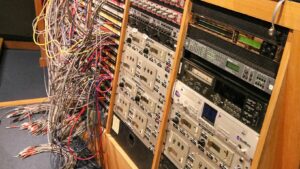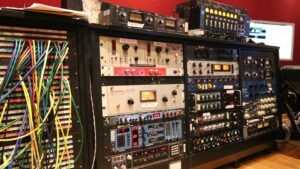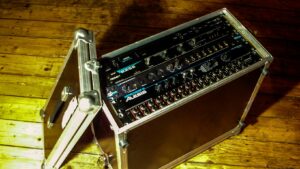In the world of audio, the equipment rack isn’t just a storage solution—it’s a critical component of a high-quality sound system. It’s where you’ll find the heart and soul of any audio setup, from the simplest home theater to the most complex recording studio.
Join us as we delve into the fascinating world of audio equipment racks, exploring their various types, uses, and the key factors to consider when choosing the perfect rack for your audio setup.
Audio Equipment Rack
 An audio equipment rack plays an instrumental role in the sound system setup. As we delve deeper into the realm of these racks, we unfold their profound importance and the diverse range available in the market.
An audio equipment rack plays an instrumental role in the sound system setup. As we delve deeper into the realm of these racks, we unfold their profound importance and the diverse range available in the market.
Audio equipment racks provide more than just a storage solution for your sound gear. They enhance the longevity of the equipment, prevent overheating, and help manage cables efficiently. These critical factors significantly influence the sound quality produced. It’s appreciable how these racks serve an aesthetically profound role, harmonizing with the décor along with ensuring sound superiority.
Different Types of Audio Equipment Racks
Audio equipment racks come in myriad forms, tailored to fit various audio setups. For instance, Portable racks are significantly suited for mobile setups, while Wall-mount racks save space and ensure easy accessibility of equipment. Open-frame racks facilitate ample air circulation, beneficial to prevent overheating.
 Conversely, Enclosed racks are equipped to offer extra protection for your audio gear. Hence, it’s crucial to make an informed selection, considering your specific needs and the specific attributes offered by each type of rack.
Conversely, Enclosed racks are equipped to offer extra protection for your audio gear. Hence, it’s crucial to make an informed selection, considering your specific needs and the specific attributes offered by each type of rack.
The right audio equipment rack does more than just hold your gear. It can improve sound quality, protect your investment, and even add a touch of style to your setup. Whether you’re a seasoned audiophile or just starting out, understanding the importance of a good audio rack can elevate your sound experience to new heights.
Assessing Audio Equipment Racks: Features to Consider
When evaluating audio equipment racks, multiple features demand attention. Among them, the four command the most attention: material quality, size and capacity, ventilation, and cable management options.
- Material Quality: A key factor in a rack’s performance, it influences sound quality. Common materials include metal, wood, or tempered glass. Metal racks often provide strength and durability, whereas wood may offer superior aesthetics.

- Size & Capacity: Tailoring to specific needs is crucial. For large professional setups, a rack with high capacity and larger size is suitable. Meanwhile, for smaller home studios, a compact rack could be ideal.
- Ventilation: Effective ventilation helps prevent overheating, critical for maintaining sound quality and equipment longevity. Open-framed racks offer excellent air circulation, while enclosed types may require built-in fans or vents.
- Cable Management: A rack equipped with cable management options simplifies wiring tasks, reduces clutter, and enhances equipment safety. This might include built-in grommets, rear panels, or dedicated cable channels.
Remember, no one-size-fits-all solution exists. Every audio setup requires a unique approach to audio equipment racks, factoring in these key features.
Caring for your Audio Equipment Rack
Choosing the right audio equipment rack is an investment in sound quality, equipment longevity, and aesthetic appeal. It’s crucial to remember that each audio setup is unique and requires careful consideration of factors like material quality, size, ventilation, and cable management. Whether it’s a portable rack for mobile setups, a wall-mount for saving space, or an enclosed rack for added protection, there’s a perfect fit for every need.
Remember, a well-chosen rack does more than store gear – it enhances sound, protects your investment, and adds a touch of class to your setup. So, whether you’re setting up a professional studio or a compact home system, don’t underestimate the impact of the right audio equipment rack. It’s not just about storage, it’s about sound, safety, and style.

